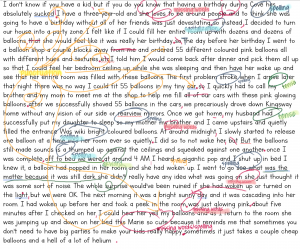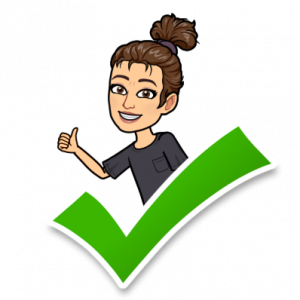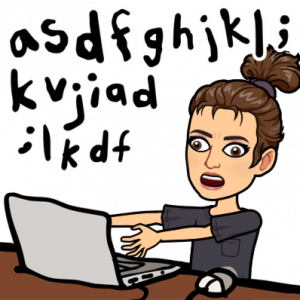Story Time – Voice to text using apple Carplay.
I don’t know if you have a kid but if you do you know that having a birthday during Cove has absolutely sucked I have a three-year-old and she loves to be around people and to think she was going to have a birthday without all of her friends was just devastating so instead I decided to turn our house into a party zone. I felt like if I could fill her entire room up with dozens and dozens of balloons that she would feel like it was really her birthday so the day before her birthday I went to a balloon shop a couple blocks away from me and ordered 55 different coloured pink balloons all with different hues and textures etc.I told him I would come back after dinner and pick them all up so that I could feel her bedroom ceiling up while she was sleeping and then have her wake up and see that her entire room was filled with these balloons. The first problem stroke when I arrive later that night there was no way I could fit 55 balloons in my tiny car so I quickly had to call my brother and my mom to meet me at the shop to help me fill all of our cars with these pink glowing balloons after we successfully shoved 55 balloons in the cars we precariously drove down Kingsway home without any vision of our side or rearview mirrors. Once we got home my husband had successfully put my daughter to sleep so my mother my brother and I came upstairs and quietly filled the entrance Was wiki bright coloured balloons. At around midnight I slowly started to release one balloon at a time into her room ever so quietly I did so to not wake her but But the balloons still made sounds is a thumped up against the ceilings and squeaked against one another once I was complete off to bed we were at around 4 AM I heard a gigantic pop and I shut up in bed I knew it, a balloon had popped in her room and she had woken up. I went to go see what was the matter because it was still dark she didn’t really have any idea what was going on she just thought it was some sort of noise. The whole surprise would’ve been ruined if she had woken up or turned on the light but we were OK. The next morning it was a bright sunny day and it was cascading into her room. I had woken up before her and took a peek in the room was just glowing pink about five minutes after I checked on her I could hear her yell my balloons and as I return to the room she was jumping up and down on her bed this Marie so cute because it reminds me that sometimes you don’t need to have big parties to make your kids really happy sometimes it just takes a couple cheap balloons and a hell of a lot of helium
What a teacher WOULD do (I know we weren’t supposed to edit the text, this is more for a visual comparison)

Questions
How does the text deviate from conventions of written English?
After reading the BLOB of words generated from my voice to text, I sadly realized l lost the small moments within the actual moment of Isla’s birthday balloon story. Boroditsky (2011) discussed this last week when she spoke about the spatiality that is created with verb choice (the example of Cheney shooting his friend) and I feel without the mechanics that English provides us, the feelings of each small moment escapes the reader. The conventions of written English are missing, for example, in the punctuation of, “Mom, Balloons” — the text feel voiceless. Without punctuation, the comma, moments are almost glossed over. Also, the misspelling and lack of capitalization are incorrect or wrong, which almost mystifies the memory. In essence, the voice to text tool is meant to reiterate a message, but without the action of a tool we are more familiar with (like a pen or even keyboard). Like Haas’ (2013) analogy with the hoe and garden, the hoe in this case is the Apple CarPlay as it regenerates my story, but the story wasn’t complete, therefore it is crucial to note “technology can have real and important, if complex, effects on writing” (p.16).
What is “wrong” in the text? What is “right”?
Wrong

The text feels empty and confusing. Since I teach English, I immediately want to correct the mechanics of the writing. I don’t even attempt reading the story because my instinct is to see all the grammatical errors first. I think that what is wrong is how the tool is not able to recreate my oral story. As Ong (2002) suggests, “Though words are grounded in oral speech, writing tyrannically locks them into a visual field forever” (p.19). Simply, in this context, writing is tyrannical and takes precedent over the message locked within the text.
Right

I have a ‘newish’ car and it has Apple CarPlay. I have learned to start saying ‘period’ or ‘coma’ in SOME instances. So in my example, there are some small moments of proper English mechanics. I also have to enunciate Isla as [eye-lay] not how her name is really pronounced, [ee-sla]. If I say my daughters name similar to how you would say “island” in Spanish [the correct way], it DOES not pick that up. I think this reflects how the technology is not “autonomous” (p.21) as Haas indicates.
What are the most common “mistakes” in the text and why do you consider them “mistakes”?
The common mistakes are connected with time. So the missing commas, punctuation, etc., are the biggest problems because the memory becomes confused. A common mistake would be how I continuously used the “so” as a filler. When I use this filler term while I am speaking it is not as distracting. However, in the context of the written text, it becomes redundant and even makes the author (me) seem like I am not proficient in English.

WHat if you had “scripted” the story? What difference might that have made?
If this was scripted, I would have time to recall the memory using all of my senses. For some reason, when using voice to text it feels like time is limited to recount the story/message. However, if I was writing this I would have tried to appeal to the reader’s senses and included metaphors, personification, and other literary devices to elicit an image for my reader. I briefly did this when I spoke about the “sun cascading into her bedroom”, but I would have chosen unique moments in the story to fully describe for my reader.
pulling it all together – Technology as text
oral storytelling, written storytelling and the indigenous PERSPECTIVE
Written story differs from oral storytelling because it lacks the complexities of tone, intonation, and enunciation. I would even argue these elements are what convey “feelings” and even a spiritual connection with regards to Indigenous perspective. So can text, and I am specifically thinking technology, replicate oral storytelling? Being the Indigenous Success Teacher for nearly 6 years has led me to rethink oral history and the importance storytelling and culture. This assignment led to see that there is a “value system” assigned with text, as Haas (2013) discusses, he also defends that it is not autonomous (p.21). Yet, Indigenous peoples are using technology as a way to preserve and revitalize oral stories that are in threat of disappearing. One example I’ve included is an Anishinaabe Elder, Alo White, who created the website, www.firstnationelders.com. Here he has recorded videos of Elders in his community sharing cultural teachings. When asked what motivated him to create the site he states “technology gives the opportunity to capture story on video and podcast for the future” (White, quoted in CBC News) . This is not to disqualify the importance of written text, As Ong (2002) defends, written text is “infinitely adaptable” (p.14) when paired with oral stories. In the example of Alo White, text has become just this: adaptable for the preservation of these cultural teachings and voices.
Article and CBC Radio Clip
https://www.cbc.ca/news/canada/thunder-bay/first-nations-elders-website-1.5993540
references
Boroditsky, L. (June 2017). [Video]. How the languages we speak shape the way we think
CBC News. (2021, April 20). Traditional Anishinaabe songs & stories just a click away thanks to new website. Retrieved from https://www.cbc.ca/news/canada/thunder-bay/first-nations-elders-website-1.5993540
Haas, C. (2013). “The Technology Question.” In Writing technology: Studies on the materiality of literacy. Routledge. (pp. 3-23).
Ong, W.J. (2002). Orality and literacy: The technologizing of the word. New York; London: Routledge.



